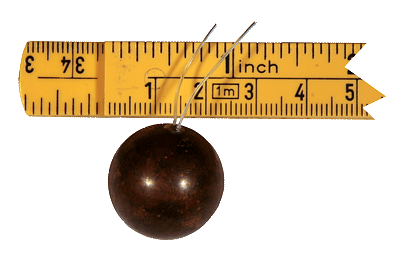Calibration for target strength measurements
Calibrating the EK80 system for velocity measurements (ADCP) ensures measurement accuracy being maintained in the current location and under current
conditions.

A 23 mm calibration sphere for 120 kHz
We strongly recommend that calibration surveys are done at regular intervals. As a minimum, calibration must be done prior to each survey.
During the startup procedure of the EK80 system, a validation check of the calibration is performed. The EK80 system checks if the last calibration was performed using the same transceiver being currently present. If this is not the case a, a message box will appear with a request for a new calibration.
Note
Calibration must be taken seriously. To achieve the best results, the calibration must be planned and done carefully.
During startup, the EK80 system will check if a calibrated transducer present is connected to the same transceiver as in the previous calibration. If not, the operator is notified, and a request to confirm the calibration is issued.
In order to calibrate the EK80, a reference target (calibration sphere) with known target strength (TS) is lowered into the sound beam. The measured target strength is compared with the known target strength of the sphere, and the EK80 is adjusted accordingly.
In this context, the transducer beam is conically shaped with a cross-section area increasing with the depth. The cross-section is divided into "slices". A split-beam transducer has three or four sectors. The circular cross-section is split into several slices.
To successfully calibrate the EK80 you need to place a number of target detections in each sector. The echoes must be distributed within the entire beam cross-section. In order to do this, the target sphere must be physically moved inside the beam during the calibration process. If the sphere location is constant, you will be rewarded with many echoes, but all will be inside the same sector. The number of sphere detections should be approximately the same for each sector, and in total not more than 100 for the whole
beam cross-section.
Any adjustments to the EK80are done automatically by the calibration program. No gain adjustments are required.
Note
When you calibrate the EK80 for target strength measurements with "live data", it is very important that you choose the correct channel, and that all
the other channels are switched to Passive mode. You must do this before you start the calibration process. To select Passive mode, use the Normal Operation dialog box. The Normal Operation dialog box is located on the Operation menu.
If you have a EK80 system with several transceivers, you must calibrate one by one.
| • | If you add a new transducer to a previously calibrated EK80 system, this new channel must be calibrated. |
| • | If a calibrated transducer is moved from one transceiver to another, you must still calibrate the transducer on the "receiving" transceiver. |
| • | If a calibrated transducer is removed, and then later reconnected to the same transceiver, the calibration data exist. A new calibration is not required. |
A new calibration may also be required after an update of the EK80 software. Refer to the software release note.
The information provided by the calibration is entered into the EK80 software as operational parameters. This is done automatically.
Tip
We recommend that you calibrate the EK80 in calm sea.
In rough sea with heave compensation activated, the calibration sphere will move up and down in the echogram. This is because the sphere follows the vessel motions, while the EK80 attempts to compensate for the same motions. In order to detect the sphere, you may even need to expand the depth limitation.
You can suppress the heave compensation by disabling the input from the sensor. However, this will remove the heave compensation information from the raw data that you record. It will then be missing if you wish to assess the calibration later using the replay functionality.
sA correction
The sA correction is only calculated for CW transmissions.
| • | When calibrating a Wide Band Transceiver (WBT), the effective pulse duration is calculated and used to establish the sA correction. This will normally result in a sA correction around 0 dB. |
| • | When calibrating a General Purpose Transceiver (GPT), the sA correction is based on the nominal pulse duration. This will normally result in a slightly negative sA correction. |